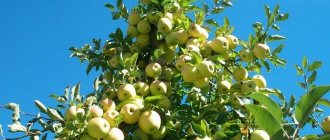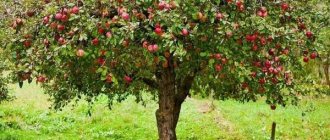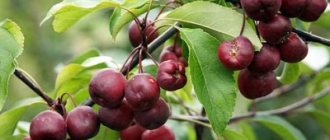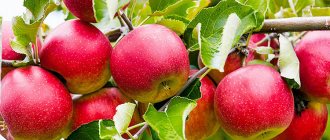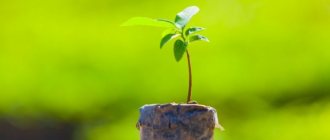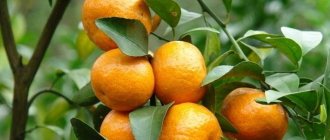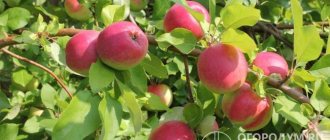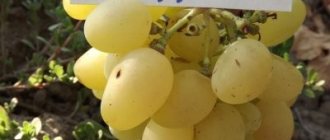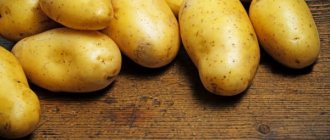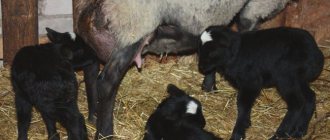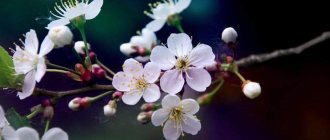The Florina apple tree is the result of the work of French breeders, who in the 70s of the last century gave gardeners a new immune winter variety, and consumers a new taste and aroma.
The history of gardening remembers that at this time scab was rampant in the gardens of Europe. The chemical industry did not have time to develop means of control - new generations of fungal disease appeared much faster.
Fortunately, on the basis of the traditional varieties “Jonathan”, “Rum Beauty”, “Golden Delicious”, as well as its clones, a new variety was developed, practically immune to all the then known five races of scab and even powdery mildew.
Description
Florin's apple tree turned out to be a medium-sized tree with a dense, wide crown.
The branches are strong, the angle of departure from the trunk is from 45° to almost a right angle. On ordinary vigorous rootstocks, the apple tree easily grows to almost 5 meters in height.
Young trees tend to thicken their crown:
- Pruning only encourages further growth.
- The buds have a medium degree of excitability - the tree recovers quite easily through dormant buds.
Flowering of “Florina” occurs in the middle period and lasts a long time - up to 2 weeks. This is very convenient, since the variety is self-sterile , and for pollination there will always be an apple tree blooming nearby.
This is interesting! Fruits begin to bear at 4-5 years (on a regular rootstock). The first harvest is up to 10 kg, but at the age of 10 it is already up to 50 kg.
Apples ripen by October:
- All of them are approximately 125-150 grams,
- One-dimensional with a dense striped blush over a pale yellow base.
- The fruits are covered with a waxy coating, which gives the red tone of the apples a purple tint, see description, photo in Fig. 1.
Fig.1. The fruits of the Florina apple tree have a waxy coating and a purple tint.
Aftercare for the apple tree
Young trees need to be watered every 2 weeks; however, Florina apple trees do not tolerate waterlogging of the soil. In conditions of heavy rainfall, watering stops.
Each seedling requires an average of 20-30 liters of water. An adult tree requires about 80 liters of water for normal development, but as soon as the apple tree reaches three years of age, the frequency of watering is reduced to a minimum.
Caring for young trees involves thinning pruning. Adult plants do not need this procedure.
Despite the fact that Florina is a winter apple variety, it is better to cover young seedlings for the winter, since in severe frosts the shoots of the plant may freeze. Spruce branches are suitable as a shelter, which will also provide protection from rodents. Adult apple trees can be protected during harsh winters by applying a layer of whitewash to the tree trunk.
Fertilizing when caring for trees is not necessary, but the variety responds well to fertilizers. Florin apple trees are usually fertilized with humus or urea, while avoiding oversaturation of the soil. In summer, plants are fed with potassium and phosphorus.
Diseases and pests, methods of control and prevention
Florina is a persistent immune variety, vulnerable only to common (European) cancer.
This is a fungal infection common in Europe, which enters plants through damage to the tree bark and gradually destroys it from the inside. The first sign of the disease is the spread of small yellow-red “peas” over the surface of the apple tree.
Prevention of infection involves preventing the appearance of cracks and burns on the tree bark. To do this, the trunks of apple trees are cleaned in the fall and covered with lime mixed with PVA glue and a solution of copper sulfate.
If cancer does strike the apple tree, the damaged area must be cleaned down to healthy areas of wood and the wound must be treated with a solution of copper sulfate. Then a layer of garden varnish is applied to the cleaned area.
additional characteristics
There are no ideal varieties, if only for the reason that it is impossible to meet universal requirements.
Advantages and disadvantages
The main advantage of the Florina apple tree variety:
- Persistent immunity to powdery mildew and most scab races . This alone significantly reduces the cost of cultivation, and the yield of the variety only contributes to its spread in industrial horticulture.
Signs of scab.
- It is important that the variety has good transportability and beautiful appearance.
Of all the varieties of winter consumption, these apples are harvested already in September , and they can be eaten immediately, and by January they acquire additional taste and aroma.
Main disadvantage:
- The frequency of fruiting, but correct agricultural technology successfully solves this problem.
The pros and cons are approximately balanced, the variety can be classified as a “golden mean” , the average resistance to drought and frost only confirms this.
Tree height
The height of the apple tree depends primarily on the rootstock.
The variety is also grafted onto vigorous rootstocks (such as “Antonovka”) - the apple tree grows higher than 4-5 meters.
Such a tree can grow near a house, but it is in no way suitable for industrial production of marketable apples, despite the yield of up to 250 kg per tree.
Gardens of agricultural enterprises usually use the cultivation of fruits on dwarf and semi-dwarf rootstocks.
Important! Even on a semi-dwarf apple tree, the “Florina” apple tree can grow up to 3 m, and on a dwarf tree it never grows lower than 1.75 m.
Crown width
The varietal feature of this apple tree is:
- Wide, rounded crown, prone to thickening.
- Skeletal eyelids are durable. They are located at an angle to the main conductor from 45 to almost 90 degrees.
Annual growth
"Florina" refers to varieties of medium vigor:
- The annual growth of shoots is usually 40-60 cm.
- Young apple trees are characterized by high activity of shoot formation.
The level of reaction of the buds to external influences is average (for example, when freezing occurs, “sleeping” buds will wake up and the tree will quickly recover).
The growth of shoots is usually 40-60 cm.
Leaf color and shape
Like all cultivated apple trees, “Florina” has whole, ovoid leaves on a small petiole:
- The base of the leaf is rounded.
- The leaf has a short tip.
- The edges of the sheet are almost smooth.
- The leaf blade is green, pubescent underneath.
Trunk color
The standard branches and trunk of “Florina” are dark gray, like most cultivated apple trees.
A change in bark color indicates either:
- About age-related changes in a tree (its old age),
- About the development of any disease.
A criterion for the health of a tree can be considered smooth bark without visible cracks or other damage.
Productivity
After planting, the Florina apple tree seedlings begin to bear fruit :
- On a weak-growing rootstock (dwarf) for 2-3 years,
- On a medium-sized rootstock (semi-dwarf) for 4-5 years,
- On a vigorous rootstock - after 7 years.
Typically, “Florina” is not grafted onto seedlings of tall varieties.
- The first stable harvest is small, usually from 5 to 10 kg per tree, obtained in the 5th year of planting.
- With proper care, a 10-year-old tree can produce from 50 to 70 kg of fruit of excellent quality.
Tasting assessment
"Florina" is grown exclusively for fresh consumption .
Among all the winter apples, this is the only variety that you can happily eat straight from the branch; it does not need to be “aged.”
Tasters rate the taste of apples of this variety as a “four plus” - 4.2-4.5 points out of 5 possible.
At first, the fruits have a sweet taste with a slight sourness. During winter storage they become even sweeter and acquire a “melon” aroma .
Winter hardiness
The winter hardiness of the variety is very average, since it was bred by breeders for the climatic conditions of Central Europe (the birthplace of the variety is France).
The drought resistance of the variety is also assessed as average, quite acceptable for the Middle Zone.
Disease resistance
When breeding Florina, special attention was paid to disease resistance. The fact is that at that time many gardens in Europe were destroyed by scab; there were 5 races of it.
Apple trees of this variety are resistant:
- To the scab (all known races),
- powdery mildew,
- Monilliosis,
- Bacterial burn.
- Even aphids do not affect it.
Attention! But there is no resistance to European cancer.
Advantages and disadvantages
Like any other variety, Florina has both advantages and disadvantages. Its positive qualities include the following:
- resistance to pests and diseases;
- long-term storage of fruits;
- pleasant taste;
- high yield.
But it was not without its drawbacks. Of these, the following should be highlighted:
- short fruiting;
- average resistance to drought and frost;
- need for pollination.
The Florina apple tree is a kind of “golden mean”. Its fruits are a wonderful delicacy, and the tree itself can decorate any area.
Reviews
In the comments of the site, visitors often leave not only questions, but also stories about their achievements and problems.
Mikhail, 42 years old, Moscow region, summer resident with 10 years of experience . “I bought a dacha recently, I was just going to relax outside the city. And suddenly I became interested in gardening. And 3 years ago, my neighbor and I stopped by a nursery - and right there we tried “Florina” from the branches, because... We found a photo and description of the variety in the literature and wanted to make sure of the taste.
I liked that you can choose a seedling according to your taste: my neighbor is fond of “columns,” but the area allows me to plant an ordinary tree. The columnar “Florina” bloomed the next year and delighted the neighbors’ grandchildren. Everything was eaten at once - what kind of storage was there...
And my first harvest this year brought more than a bucket. My wife immediately hid some of it for the New Year, on the table...”
Vladimir, 62 years old, Krasnodar region, experienced gardener. “I’ve lived all my life in Kuban, everyone has a vineyard and a garden near their house. The wonderful variety “Florina” is productive and practically disease-free. The biggest problem is not to miss when installing supports .”
Valentina, 45 years old, young grandmother, Kursk. “We have a parental home in Rylsk. For some reason, everyone around them has one “Antonovka” planted. And my father brought “Golden Delicious” and “Florina” seedlings from Ukraine a long time ago. Everyone was afraid that the varieties were non-native. The neighbors are jealous now, they ask for cuttings for grafting. There are enough apples to eat and put in the basement for the winter. The kids will be provided with apples until spring, it’s a wonderful variety.”
Fruiting of the Florina variety on rootstock M 26.
Preparing for winter
If the florina variety is grown in a temperate climate, then it is necessary to prepare the apple tree for winter so that it does not die.
- First you need to wrap the bottom of the trunk with rags.
- Then the wood is whitewashed several times. Mandatory at the end of the autumn period, and with the onset of the spring period.
- Around the tree, close to the trunk, it is necessary to mulch using foliage, which must be treated with urea.
- This is the preparation for the winter period of the Florina variety.
Features of planting and care
Landing
Deadlines
The time to plant a tree depends on the winter hardiness of the particular variety and the climate of the area. Old school gardeners had a rule that has not lost its relevance. The time of planting a fruit tree was determined by the type of fruiting.
ADVICE! For ease of memorization, we used the formula: “pome fruits in the fall, stone fruits in the spring.” Apple trees (like pome trees) are preferably planted in the fall, a month before the first frost. During this time, the root system has time to acquire small roots. The roots do not have a rest period, unlike the above-ground part of the tree.
Autumn planting is always preferable at latitudes below Moscow, where the soil does not freeze until almost December.
In more northern regions, spring planting is preferable. The apple trees simply will not have time to acclimatize to the new place and will die in the winter.
They should be planted as early as possible in pre-prepared holes.
Spring planting of seedlings requires more frequent watering, unlike autumn . Autumn precipitation completely solves the problem of supplying water to seedlings.
Technology
When choosing a location, you should remember that this apple tree can grow on almost any soil - just not acidic.
Therefore, before planting, it is better to lim the area . To plant young apple trees, spacious holes are prepared in advance and filled with organic matter and peat.
The roots of the seedlings are spread freely in the hole and covered with soil mixture.
After abundant watering, the tree trunk circle is mulched.
Distance
IMPORTANT ! The spacing between Florina trees depends solely on the rootstock used . Very often, gardeners place young trees too densely.
It’s hard to see 4-meter trees in 2-year-old seedlings, which in 10 years will compete with each other for living space and, as a result, grow even larger. There is no need to talk about the quality of the harvest.
To avoid having to “put under the knife” these fruit thickets, you should immediately think through a planting scheme.
Scheme
Planting scheme.
Depending on the type of rootstock used, apple tree seedlings are placed according to the following scheme:
- Vigorous - 6 x 4 m,
- Medium height (semi-dwarf) - 5 x 2.5 m,
- Weak-growing (dwarfs) - 4 x 2 m,
- Columnar - 2 x 0.75(0.5) m.
It is better to immediately take care of purchasing seedlings on weak-growing rootstocks than to uproot the garden after 10 years.
Free row spacing can be occupied with currants for now:
- She has no common diseases with apple trees,
- In just 10 years, her bushes will grow old and will need to be removed.
Growing
“Florina” is a winter apple variety for warm regions of temperate latitudes .
The tree is unpretentious in maintenance, since it is practically not susceptible to fungal diseases. This quality minimizes the number of chemical treatments, which reduces the cost of industrial gardening.
An apple tree shaped like a spindle.
Peculiarities include the frequency of fruiting , but this problem can be solved with special agricultural techniques:
- Yield rationing (including chemical methods),
- Proper pruning,
- Competent feeding regime.
ADVICE ! Tree overload with harvest can also be attributed to the characteristics of the variety. The problem can be solved by specially shaping apple trees in the shape of a spindle or by timely installation of supports.
Agricultural technology
“Florina” feels great on black soil and loams, but does not tolerate acidic soils at all . Therefore, using lime when planting will not harm in any case.
For planting a young apple tree:
- Prepare a pit 60 x 80 cm,
- It is filled with organic matter and peat soil.
- They drive in a peg, tie up a seedling,
- Sprinkle its roots with a mixture of soil and applied fertilizers.
- Water well and mulch.
Proper planting of an apple tree.
Adult apple trees do not have any special care requirements:
- In spring - weeding and fertilizing;
- In summer, it is necessary to loosen the top layer to supply the roots with oxygen;
- In autumn - loosening the soil and removing fallen leaves.
"Florina" is very responsive to watering , especially during fruit filling.
Pruning and crown formation
Young trees are prone to strong crown thickening; their pruning is especially carefully monitored .
The crown shape of this variety is close to spreading; branches can break off under the weight of the harvest . To prevent this from happening, thin out the crown as much as possible - the quality of the apples will only improve.
Pruning is carried out in early spring before active growth begins.
The crown is either thinned out and left to grow freely, or formed spindle-shaped .
Advice! Watch the branches while loading the crop - place supports so that the load of apples does not break the tree.
Pollinator varieties
Unfortunately, the variety requires pollination . If you let the process take its course (free pollination), then up to 25% of the fruits are set.
It’s good if they grow nearby:
- "Golden Delicious" (or its hybrids),
- "Idared"
- "Liberty"
- "Gloucester".
These are the best pollinators for Florina. The percentage of ovary formation increases to 32% and there are never less than a quarter of the opened buds.
Only one variety with incompatible pollen - "Priscilla".
Apple tree variety Priscilla.
Advantages and disadvantages
| Advantages of the variety | Minuses |
|
|
Features of ripening and fruiting
Beginning of fruiting
The aboveground and underground parts of any tree are inextricably linked, not only in the literal sense. The type of rootstock affects the fruiting of the scion , including the time at which fruiting begins.
Under equal growing conditions, “Florina” enters the fruiting stage at:
- 3 year in case of dwarf rootstock,
- 4-5 years on semi-dwarf rootstock,
- 7 years old - vigorous.
Deadlines
Blooms
The self-sterility of “Florina” is compensated by long flowering in the middle period.
Since apple trees grow everywhere, there is sure to be a blooming one nearby, and the problem solves itself.
Fruit ripening
In the central zone, “Florina” is suitable for harvesting (technical maturity) in the last days of September.
Harvest of Florina apples.
Unlike most winter varieties, these apples taste great fresh from the tree.
What is important is that these fruits hold well on the stalk even after ripening. Apples not intended for storage do not need to be removed immediately - they will only gain flavor on the branches and acquire a “florin” aroma.
Fruit storage
The whole bouquet of taste and aroma is revealed after aging” in storage only closer to the New Year holidays. Apples can be stored until March, and in the refrigerator until June.
In order to successfully preserve apples with minimal losses , it is important to follow certain rules:
- Harvest fruits for storage only at the stage of technical maturity (they fall off 5 pieces per day).
- Use gloves - apples should be as whole as possible.
- Fruit harvesting begins from the lower branches, moving gradually to the top.
- The stalk should remain with the apple.
- Do not wipe off the waxy coating.
- Place apples immediately into containers.
ADVICE ! Keep the picked apples for 2-3 weeks in a cool room, carefully sort through them and sort them by size. To store in the basement, place apples in 2-3 layers with the tails facing up.
The main requirement for containers is absolute cleanliness; the material can be any.
There is no need to cover it with paper - ventilation should be maximum.
For the refrigerator, place apples in plastic bags with slits for ventilation.
Features of fruit formation
Apples of the Florina variety help people in winter to replenish the body with valuable vitamins and useful components. It is recommended to consume 1 fruit daily to restore the functioning of the intestines, improve the condition of the skin, and strengthen blood vessels and bones. Fruits have valuable properties necessary to strengthen the heart. You can also use iodine-containing bones, but their consumption is limited to 5 pieces daily.
Experienced gardeners claim that the variety is not intended for preparing preparations for the winter. These fruits are not subject to high-quality processing, although juices can be made. High shelf life and the ability to preserve taste parameters allow you to consume the fruit raw throughout the winter. They are added to a variety of dishes, for example, in salads or desserts.
Florina begins to bear fruit after 2-3 years if the rootstock is weak-growing, and from 4-5 years if the rootstock is of medium height. A five-year-old tree produces 5-10 kg of harvest, and a 10-year-old tree produces 60-70 kg. Harvesting maturity occurs at the end of September or in the first weeks of October. Consumer maturity refers to January.
The harvest is harvested on dry days. Florin apples must be removed carefully so as not to tear off the branch. First, the fruits are picked from the lower levels, and then they are directed upward. You should not get rid of the waxy coating. Fruits are not washed before storage. The collected apples are sorted. Whole fruits should be stored in boxes made of wood or plastic in three layers, no more. Damaged fruits must be consumed without storage.
Subspecies and variants of the Florina variety
The variety of forms allows you to choose the appropriate option for each specific case.
French gardeners have received a fruit tree that can be grown in completely different forms - from a large 4-meter tree to a neat “column”.
Red
On a regular vigorous rootstock, the apple tree reaches a height of 4 meters. Such a tree creates many problems .
Moreover, pest control and pruning are far from the most difficult.
Branches loaded with crops must be supported or otherwise protected from breaking the trunk.
The yield of the variety creates the main problems for the gardener.
Columnar
Growing a columnar apple tree solves many problems.
Such apple trees in a row can be planted even at a distance of 0.5 m in a row with a row spacing of 1.5-2 meters.
There is always a place for such compact apple trees in any country house.
The “column” has another important advantage - it is easy to cover for the winter .
This means that the variety easily moves north in amateur gardening.
There are confirmed facts that these apple trees successfully bear fruit in the Leningrad region if the tree trunk is covered with mulch and the tree itself is wrapped in burlap or agrofibre.
Winter
Apples picked at the stage of technical maturity rarely differ in taste and aroma. But for “Florina” an exception can be made. Already at the end of September they are very tasty. Storing until the New Year holidays only gives them the characteristic “Florin” aroma of ripe melon.
Under special conditions, apples are stored until March, and in the refrigerator - even until June.
Important! The safety of fruits is influenced primarily by the technology of their collection. The slightest damage to the skin quickly leads to rotting.
Immune
The immunity of foreign apple tree varieties is an order of magnitude higher than that of domestic ones.
One of the most significant problems of the Middle Zone is regular epidemics of scab and other fungal diseases. Without repeated chemical treatments, not only the crop will die, but the entire garden.
Reducing the number of chemical treatments makes it possible to grow environmentally friendly apples.
By planting a garden with varieties that are not afraid of fungal infections , the number of garden treatments is significantly reduced.
Not only are labor and cost costs reduced, there is now a real opportunity to grow organic fruit .
The “Florina” variety, with its resistance to scab and powdery mildew, when grown on dwarf rootstocks and in the form of columns, can provide not only amateur gardeners with tasty winter apples.
Apple tree Florina
The Florina apple tree is a picky variety. It appeared as a result of the work of French breeders, using the genome of several varieties: Starking, Rum Beauty and Jonathan.
Characteristic
The Florina variety bears fruit periodically, taking a break every 3 years. Annual rationing of the crop improves marketability. This helps ensure that the apples do not become smaller. Excess ovaries should be removed. In gardens this is done manually, and in industrial farms - with the help of chemicals.
This is a winter variety. The harvest begins closer to October. It has excellent performance in areas with warm climates. After lying for a while, the fruits only get better.
Description of the tree
An adult tree reaches a height of 3 m. On soils poor in nutrients or on a dwarf rootstock, it grows up to 2 m. The crown of the tree is dense due to the abundance of foliage. Young trees are characterized by increased shoot formation. Has mixed fruiting. Most of the fruit comes from annual growth.
Flowering occurs over a long period of time.
Description of fruits
Apples are round. The weight reaches 150 g. The peel is not thick and elastic. Subcutaneous inclusions of light color are visible on the surface of the fruit. The main color of apples is red. It has streaks or blush with a slight bluish cast. The pulp is dense, greenish-white, juicy. When cutting an apple, a wonderful subtle aroma is felt.
Application of fruits
The fruits are consumed fresh. They also make delicious juice. Despite its sweetness, the variety is not used in the production of jam, jam and marshmallows.
The fruits are rated at 4.8 points. They have a non-sweetening taste: sweet with a subtle hint of sourness. A few months after harvesting, they resemble melon in their taste and aroma.
Winter apples usually acquire the characteristic taste qualities of their species after some time, and the fruits of the Florina variety can be consumed after being picked from the tree immediately after ripeness.
This variety does not tolerate frost very well.
For the first time, the Florina variety began to be planted on Ukrainian lands. It has been cultivated in industrial quantities since 1980. It was from this time that apple plantations were planted.
The apple tree, due to its low frost resistance, has spread to areas of Russia with a temperate climate (middle zone).
Productivity
Depending on the rootstock used, from 70 to 150 kg of fruit are removed from the tree. It also influences the onset of the fruiting period:
- vigorous - for 7 years;
- semi-dwarf - for 5 years;
- dwarf - for 3 years.
Pollinator varieties
The culture is self-sterile. If additional pollination is not provided, up to 26% of the possible number of fruits is set. To increase the volume of ovaries, pollinators must grow next to the apple tree. Such species as Ruby Dukes, Liberty, Golden Delicious, etc. cope with this task.
Winter hardiness
The Florina variety is not winter hardy. In cold conditions it does not take root and freezes out. It also shows poor results in terms of drought resistance.
In the process of crossing, breeders achieved high resistance of the variety to diseases and pests such as:
- powdery mildew;
- moniliosis and bacterial burn;
- scab;
- aphid.
Advantages of the Florina apple tree variety:
- disease resistance;
- high taste and presentation;
- shelf life up to 6 months;
- the ability not to lose its presentation during transportation;
- high yield.
- fruiting occurs periodically, but compliance with the rules of agricultural technology allows you to level out this problem;
- poor winter hardiness and drought resistance.
Landing
Excellent and high yield
For proper development and constant increase in productivity, you need to carefully consider the process of planting the selected seedling.
Start planting the Florina apple tree in early spring or autumn. Each method has its own advantages. When planting in autumn, you can choose the best from a large number of seedlings by paying a reasonable price.
A warm autumn will provide an opportunity for the roots to strengthen well, and the plant will accumulate strength until the cold weather. If planting is late, the seedling may die before it has time to grow stronger.
When planted in late spring, apple trees grow quickly and develop a root system. The optimal time for the spring procedure is April - May. At later dates, the plant has difficulty taking root.
By purchasing a seedling in the fall, you can plant it in the spring. In this case, lay the apple tree in the ground obliquely in a trench dug up to 40 cm deep with the top to the south. Cover the roots and 1/3 of the trunk with soil.
Selecting a location
An important step is choosing a landing site. Pay attention to the sunny part of the site. In a shaded place, poor formation of ovaries and, as a result, the formation of small and sour fruits is possible. The distance to neighboring trees should not be less than 3 m.
An important factor is the direction of the wind. In northern winds, it is better to hide the Florin apple tree behind buildings. In the absence of drafts, more intense pollination by insects occurs. The seedling takes root well both in chernozems and in soils with a clay base. However, in terms of acidity, it is better to choose neutral or slightly acidic soil.
Selection of seedlings
When everything is ready for planting, they begin to select a seedling. It is better to give preference to young trees grown in the same area where the procedure will take place. When examining a seedling, it is important to consider several factors that contribute to better adaptation of the apple tree:
- age – 1-2 years. This seedling takes root easily. The annual tree still has no branches. At the age of 2 there are already two branches;
- The trunk is smooth and without defects, the bark is clean. The wood underneath is lush green. If it is brown, the tree is not viable;
- the seedling has several main roots with a network of thin roots. They should not show any defects;
- the graft is located 8 cm above the root system.
Pit preparation
According to the rules of agricultural technology, a hole is dug and fertilized long before the tree is planted. When planting in autumn, it is prepared a month in advance, and in spring - from autumn. To do this you need:
- clean the planting site from weeds and roots and do not plant it in the place where apple trees grew before;
- the pit should be 80 cm deep and 1 m in diameter;
- discard the top layer of soil to the side. Add 2 buckets of humus, 800 g of ash to the ground and mix thoroughly;
- pour a third of the soil back into the hole, forming a hill in the middle;
- drive a stake in the middle to tie the seedling;
- water the hole with two buckets of water.
Landing technology
Proper planting of seedlings is necessary to obtain fruits.
Proper planting promotes rapid adaptation of the tree to a new location and active growth. The technological process consists of the following stages:
- one day before planting, the roots of the apple tree are soaked in water, to which you can add the growth stimulator “Epin Extra” (description of use in the instructions);
- before planting, they are dipped into a mash made of clay, water and mullein;
- spread the roots evenly over the hill;
- shaking the seedling, cover the roots with prepared soil;
- the grafting site should be 5 cm above the ground level and directed to the south;
- compact the soil around the trunk and tie the tree to a support;
- water the tree with 2 buckets of water;
- carry out mulching, stepping back a little from the trunk.
After planting and throughout its life, the tree needs proper and timely care.
During the first 3 years, the tree trunk circle must be constantly moistened. Mature trees do not need this: they are watered only during dry summers.
Watering is required during the following periods:
- awakening of the kidneys;
- formation of the ovary;
- 2 weeks before harvest;
- Moisture-charging irrigation is needed if there is no rain in October.
Volume of water depending on the age of the tree:
- up to 3 years – 3 buckets of water;
- up to 5 years – 8;
- over 5 – 15.
Use soil loosening and mulching to protect the surface from crust formation and rapid evaporation of moisture.
Feeding
During the entire growing season, the tree needs different types of feeding:
- in April, after watering, root feeding (100 g of urea per 10 liters of water);
- Trees up to 3 years old need foliar feeding to grow foliage;
- in May, along the tree trunk circle, at a short distance from the trunk, we evenly distribute the humus and loosen it. In order for the fertilizer to reach the roots, abundant watering is necessary;
- in July, feed the apple tree by diluting 150 g of superphosphate and 120 g of potassium in 30 liters of water. Use the resulting solution to water the holes around the perimeter of the tree trunk;
- after harvesting, add a mixture of 300 g of potassium and 300 g of phosphate, dissolved in 30 liters of water, into the tree trunk circle. In the absence of rain, we carry out preliminary watering.
Normalization of the ovary
The operation of standardizing the ovaries is necessary to improve the quality of the future harvest. Start this 2 weeks after flowering. Keeping a distance of 18-20 cm between the ovaries, only the largest ones are left.
Apple trees should be rejuvenated
The process of crown formation is necessary not only to give the tree a beautiful appearance and prevent thickening, but also to rejuvenate the apple tree.
At 1 year of age, the Florina apple tree is pruned when it reaches 80 cm. The buds that remain give rise to new branches. They will continue to be formed next year.
A two-year-old tree requires highlighting the center and skeletal branches. The remaining shoots are pruned into a ring. The branches that are directed to the sides are shortened by 30 cm. Later, as soon as the tree grows to the required height, the central branch is cut off.
As the apple tree ages, it continues to be thinned, using sanitary pruning if necessary to prevent the development of diseases.
Preparing for winter
When preparing for cold weather, seedlings require special care. To protect them from frost, wrap the trunk and skeletal branches with breathable material (thick paper, burlap). The branches are connected to each other. Place a layer of manure or soil mixed with peat in the area around the tree trunk.
For mature Florina apple trees, whiten the trunk. Tie the tree with spruce branches to protect it from rodents. Cover the root area with mulch.
The Florina apple tree may be subject to pest invasion. Most often it is attacked by two types of parasites:
- leaf roller. The caterpillars form a cocoon from the leaves, where they transform into a pupa. To combat them, use the drug “Calypso”, which is used before flowering, “Ditox” - after (description of use in the instructions). For prevention in the fall, collect and burn leaves, regularly cover the trunk with whitewash. Attract birds by placing bird feeders or collect pests by hand;
- apple blossom beetle. As soon as the buds open, a small beetle wakes up and begins to eat them. Then it switches to the buds, where it lays eggs, and the emerging larvae eat the bud from the inside. Using drugs such as Iskra and Karbofos during the period when buds are breaking, you can get rid of these parasites. As a preventative measure, whiten the tree trunk. Loosen the soil around the tree trunk. Use catch belts. Shake off insects onto a cloth, spreading it under the tree.
Application of fruits
Growing in regions
The brainchild of French gardeners, “Florina” has very mediocre frost resistance. This indicator is decisive when choosing a variety for cultivation in Russia.
In the middle zone and Moscow region
Considering the very average indicators of winter hardiness , in the central zone north of the Moscow region it is not advisable to grow “Florina” without a special winter shelter: it is too troublesome, and the result is unpredictable.
It is better to plant a garden from reliable zoned varieties.
However, by planting this variety of French selection and reliably covering the root circle for the winter, you will get a good harvest of tasty winter apples.
The gardens of the Middle Zone suffer greatly from scab, but “Florina” is not afraid of it, as well as powdery mildew, moniliosis and fire blight. The number of garden treatments with chemicals is automatically - ecological products are now in trend.
There is one problem that gardeners do not encounter except in Russia - hares and rodents. Young trunks are tied with spruce branches and juniper, and the trunks are coated with lime with special additives.
In Ukraine
The climatic conditions of Ukraine, especially the central part (steppe and forest-steppe), differ little from France .
Winters are colder, but the temperature rarely drops below -20°C and not for long, which has virtually no effect on the wintering of fruit trees.
Usually a lot of snow falls in winter - the roots do not suffer from the cold , and in the spring the tree does not lack water.
During flowering (late May), possible frosts are unlikely; flowers and ovaries cannot be damaged in any way. During fruit loading (June-July) it often rains, but “Florina” is not afraid of powdery mildew and scab.
History of selection
A variety of French selection, created in the middle of the 20th century by repeatedly crossing the Abundantly flowering apple tree (Malus floribunda) and varieties:
- Starking is a donor of yield and large fruit;
- Rum Beauty – red apples, sweetness;
- Jonathan - attractive appearance, tender pulp and long shelf life;
- Golden Delicious – yield, sweet taste.
Florina gained particular popularity in the USA. The variety was brought to the USSR in the 70s of the 20th century, and in 1980 it was introduced into industrial horticulture in Ukraine. Adopted by the State Register of the Russian Federation in 2000, it is recommended for the Central region and the North Caucasus.
Feeding and watering
The first watering is done before the buds open. The second watering is carried out 2 weeks after the color falls off. The apple tree is watered for the third time 2 weeks before harvesting the fruit. And finally, in October, the final watering is carried out. Be sure to water the apple tree while preparing for winter, so it will gain additional resistance to cold weather.
According to watering standards, older trees require more water. A young apple tree needs 3 buckets of water, a five-year-old tree needs at least 5 buckets, and an old tree needs up to 15 buckets. If you water according to all the rules, it will definitely increase the yield by 20%.
Ash should be added to the soil around the tree from time to time. The area for applying ash depends on the crown - the diameter of the crown is projected onto the ground, this will be the area required for applying fertilizer. At least 2 kg of ash is required per 1 sq. m.
